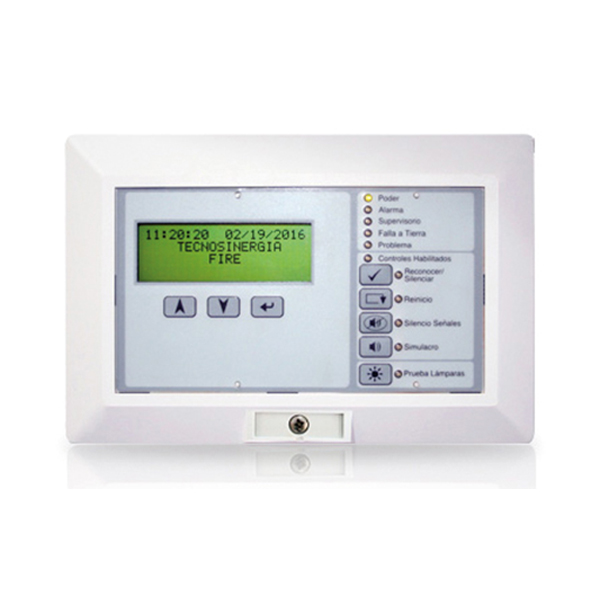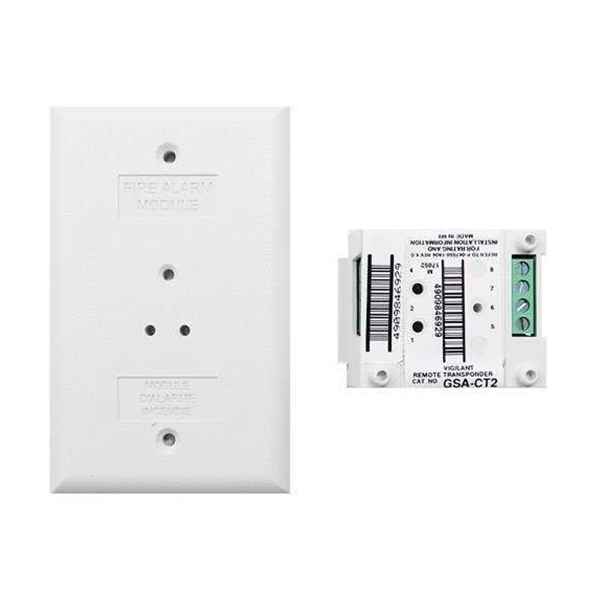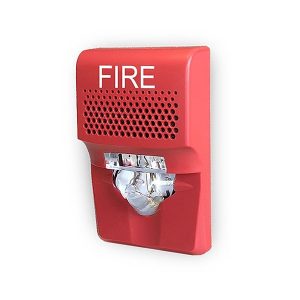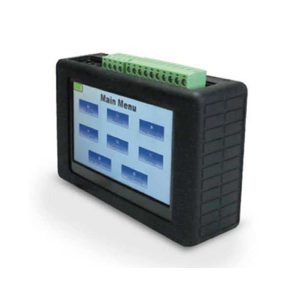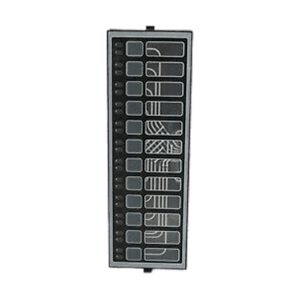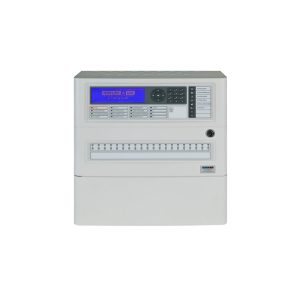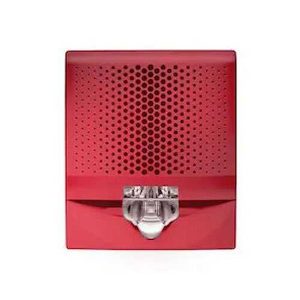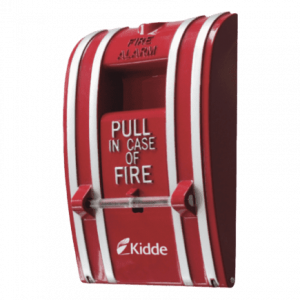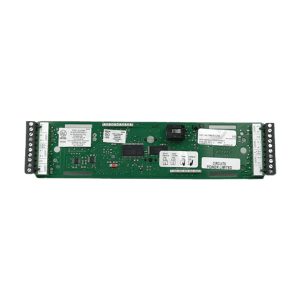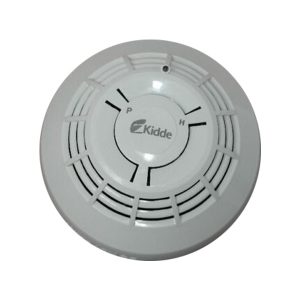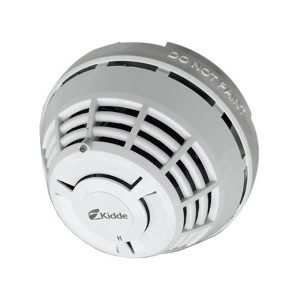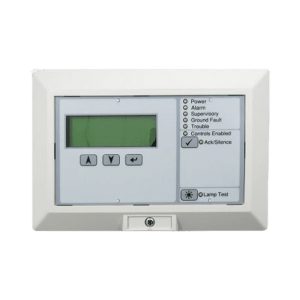Kidde Vigilant GSA-CT2 Dual Input Module
Key Features:
- Multiple applications Including Alarm, Alarm with delayed latching (retard) for waterflow applications, Supervisory, and Monitor. The installer selects one of four “personality codes” to be downloaded to the module through the loop controller
- Plug-in (UIO) or standard 1-gang mount UIO versions allow quick installation where multiple modules are required. The 1-gang mount version is ideal for remote locations that require a single module.
- Automatic device mapping Signature modules transmit information to the loop controller regarding their circuit locations with respect to other Signature devices on the wire loop.
- Electronic addressing Programmable addresses are downloaded from the loop controller, a PC, or the Signature Program/Service Tool. There are no switches or dials to set.
- Stand-alone operation The module makes decisions and inputs an alarm from initiating devices connected to it even if the loop controller’s polling interrogation stops. (Function availability dependent upon control panel.)
- Ground fault detection by address Detects ground faults right down to the device level.
Description
Signature Series Overview
The Signature Series intelligent analog-addressable system from Edwards Security is an entire family of multi-sensor detectors and mounting bases, multiple-function input and output modules, network and non-network control panels, and user-friendly maintenance and service tools. Analog information from equipment connected to Signature devices is gathered and converted into digital signals. An onboard microprocessor in each Signature device measures and analyzes the signal and decides when to input an alarm. The microprocessor in each Signature device provides four additional benefits – Self-diagnostics and History Log, Automatic Device Mapping, Stand-alone Operation and Fast, Stable Communication.
Self-diagnostics and History Log – Each Signature Series device constantly runs self-checks to provide important maintenance information. The results of the self-check are automatically updated and permanently stored in its non-volatile memory. This information is accessible for review any time at the control panel, PC, or using the Signature Program/Service Tool.
Automatic Device Mapping –The Signature Data Controller (SDC) learns where each device’s serial number address is installed relative to other devices on the circuit. The SDC keeps a map of all Signature Series devices connected to it. The Signature Series Data Entry Program also uses the mapping feature. With interactive menus and graphic support, the wired circuits between each device can be examined. Layout or “as-built” drawing information showing branch wiring (T-taps), device types and their address are stored on disk for printing hard copy.
Installation
The GSA-CT2 module mounts to North American 2½ inch (64 mm) deep 1-gang boxes and 1½ inch (38 mm) deep 4-inch square boxes with 1-gang covers and GSA-MP mounting plates. The terminals are suited for #12 to #18 AWG (2.5 mm2 to 0.75 mm2) wire size
Electronic Addressing – The loop controller electronically addresses each module, saving valuable time during system commissioning. Setting complicated switches or dials is not required. Each module has its own unique serial number stored in its on-board memory. The loop controller identifies each device on the loop and assigns a “soft” address to each serial number. If desired, the modules can be addressed using the Signature Program/Service Tool.
Edwards recommends that this module be installed according to latest recognized edition of national and local fire alarm codes.
Application
The duty performed by the GSA-CT2 is determined by their sub-type code or “Personality Code”. The code is selected by the installer depending upon the desired application and is downloaded from the loop controller.
Two personality codes can be assigned to the GSA-CT2. Codes 1, 2, 3 and 4 can be mixed on GSA-CT2 modules. For example, personality code 1 can be assigned to the first address (circuit A) and code 4 can be assigned to the second address (circuit B).
NORMALLY-OPEN ALARM – LATCHING (Personality Code 1) – Assign to one or both circuits. Configures either circuit A or B or both for Class B normally open dry contact initiating devices such as Pull Stations, Heat Detectors, etc. An ALARM signal is sent to the loop controller when the input contact is closed. The alarm condition is latched at the module.
NORMALLY-OPEN ALARM – DELAYED LATCHING (Personality Code 2) – Assign to one or both circuits. Configures either circuit A or B or both for Class B normally-open dry contact initiating devices such as Waterflow Alarm Switches. An ALARM signal is sent to the loop controller when the input contact is closed for approximately 16 seconds. The alarm condition is latched at the module.
NORMALLY-OPEN ACTIVE – NON-LATCHING (Personality Code 3) – Assign to one or both circuits. Configures either circuit A or B or both for Class B normally-open dry contact monitoring input such as from Fans, Dampers, Doors, etc. An ACTIVE signal is sent to the loop controller when the input contact is closed. The active condition is not latched at the module.
NORMALLY-OPEN ACTIVE – LATCHING (Personality Code 4) – Assign to one or both circuits. Configures either circuit A or B or both for Class B normally open dry contact monitoring input such as from Supervisory and Tamper Switches. An ACTIVE signal is sent to the loop controller when the input contact is closed. The active condition is latched at the module.
Typical Wiring
Modules will accept #18 AWG (0.75mm2), #16 (1.0mm2), and #14AWG (1.50mm2), and #12 AWG (2.50mm2) wire sizes. Note: Sizes #16 AWG (1.0mm2) and #18 AWG (0.75mm2) are preferred for ease of installation. See Signature Loop Controller catalog sheet for detailed wiring requirement specifications.
Notes
- Maximum 25 Ohm resistance per wire.
- Maximum #12 AWG (2.5 mm²) wire; Minimum #18 AWG (0.75 mm2).
- Refer to Signature controller installation sheet for wiring specifications.
- Maximum 10 Vdc @ 350 µA 5 The GSA-UIO6R and the GSA-UIO2R do not come with TB14.
- All wiring is supervised and power-limited.
- These modules will not support 2-wire smoke detectors
Warnings & Cautions
This module will not operate without electrical power. As fires frequently cause power interruption, we suggest you discuss further safeguards with your local fire protection specialist.
Compatibility
The Signature Series modules are compatible only with Vigilant’s Signature Loop Controller.
Technical Specifications
| Description | Input Module |
| Type Code | 48 (factory set) Four sub-types (personality codes) are available |
| Address Requirements Uses | Two Module Addresses |
| Operating Current | Standby = 396µA; Activated = 680µA |
| Operating Voltage | 15.2 to 19.95 Vdc (19 Vdc nominal) |
| Construction | High Impact Engineering Polymer |
| Mounting | UIO2R/6R/6 Motherboard |
| Operating Environment | 32°F to 120°F (0°C to 49°C) |
| Storage Environment | -4°F to 140°F (-20°C to 60°C); Humidity: 0 to 93% RH |
| LED Operation | On-board Green LED – Flashes when polled; On-board Red LED – Flashes when in alarm/active. Both LEDs – Glow steady when in alarm (stand-alone) |
| Compatibility | Use with Signature Loop Controller |
| Agency Listings | UL, ULC, MEA, CSFM |
| Weight | 1.00 lbs |
| Manufacturer | UTC Fire & Security |
| Brand | Vigilant |
| Condition | New |
| Type | Intelligent Module |
| Style | Dual Input |
| Mounting | 1-Gang |
| Programming | Electronic |
| Protocol | Signature Loop Controller |
| Voltage | 19 VDC |
| Voltage Range | 15.20 – 19.95 VDC |



